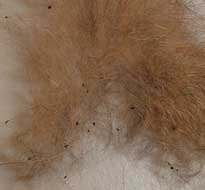My Dog Keeps Shivering What Does That Mean
Summary: Flea dirt is actually flea poop that is made up of dried blood. They look like tiny dots (usually black in color) and are a sure sign that fleas are on your pet or around their living areas. They are commonly found on the tummy and on the tail. Fleas need to be dealt with immediately to prevent health risks and you also need to take preventative measures to try and keep fleas away.
Fleas can be difficult to deal with, especially during the warmer months when they are the most active. However, there are a few signs of fleas that you can keep an eye out for if you want to stop a potential flea problem dead in its tracks. One of the biggest give away that your poor pet has a bad case of fleas is the flea dirt that can be found on your dog or cats hair. Lets take a few moments to learn how to properly find it, identify it and work out an effective solution for getting rid of the fleas and their dirt in a safe and thorough manner. If you have questions, please leave a comment below the article and I will get back to you soon asap. 🙂
Flea Dirt Identification – What Is Exactly Is It?
Basically, this type of "dirt" is old blood and feces that is left behind when fleas feed on your pet. This dry blood gives them a "black" appearance on skin or hair. If you touch it, it will feel slightly "grainy", much like fine sand. Gross I know! They are usually about half a millimeter in length and they leave little marks that are often described as looking like:
- Black pepper
- Tiny Black Dots
- Black Specks
- Dog or cat "dandruff" that is dark in appearance
- Small tar colored "flakes"

Picture of Flea Dirt 
Regardless of how you see it, if you find something like that on your pet, it definitely deserves some attention. How so? Well flea dirt indicates the presence of fleas. While you may not find any fleas upon first inspection, remember that there may be flea eggs already laid on your pet and secondly, there is a good chance that the flea jumped to safety before you could notice it feeding on your pet. Since fleas pose a health risk to your pet, you need to take action as soon as possible. I will go into more detail on this subject a little later.
Many people have asked how to tell the difference between dirt from fleas and just normal dirt that may be picked up from the garden or surrounding areas. If you have wondered this before, it's actually a very good question as incorrect diagnosis can potentially cost you money unnecessarily. Also, if you find this dirt, you may also want to invest in a monthly treatment product to keep your pets flea free but please do not use a flea collar for dogs or cats as these can be very dangerous. Products such as Frontline and Advantage are very good and are worth their price tag. Here are a few ways to check if the "dirt" that you see is actually flea excrement:
- Take a paper towel (toilet paper or cotton balls should be fine as well) and put a very small about of water on it. Gently rub your pets fur where you think there may be flea poo and if it appears a reddish brown color (on the paper), its highly likely that its flea poo.
- Another way to check is to do use a comb to brush some of the "dirt" off your dog or cats fur and onto a white surface. Once you have collected a bit, also apply a few drops of water and see if the color changes into the same, red stain from the digested blood.
Remember, if you pets enjoy swimming or live outside, remember that the dirt may look like brown-red streaks that are created from flea waste when it comes into contact with moisture (dew, rain, etc.)
Where Can You Find Flea Dirt?
While fleas are not be too picky about the areas of residence, there are a few places where they are known to congregate. Its in your best interest to know these places so that you have a good idea where to start looking. Here are the steps that I personally follow:
- The first thing I usually do is check for this dirt on my pets on bedding, unless I actually notice the dirt on my dog or cats fur first of course. Remember to use the "water technique" to check if it turns that red brown color. In fact, it's a good idea to check this area from time to time to see if there is a bigger flea problem waiting to happen. Also, if you see your pet scratching continuously, its very possible that there may already be a flea infestation in the house so try and keep an eye out for this dirt (and signs of fleas) on a weekly basis.
- Secondly, I would spend some time inspecting my dogs and cats fur, regardless of whether I find the dirt in their sleeping areas. I do this by pushing the fur apart to ensure that I don't miss anything. Sometimes you may even see the fleas, unless there are very few. Pay extra attention to the belly area and on the back of the tail. Other common places include the paws (especially if its an outdoor pet) and under the arms (or technically, its legs).
If You Have Found This Dirt on Your Pet, What Are the Risks?
Despite their size, fleas consume a large amount of blood, especially if there is a large amount of them. While its rather rare and only a result of a terrible flea problem, this can result in anemia. Also, since larvae uses this dried blood to sustain them during their life cycle, its in your best interests to get rid of both the fleas and their dirt as soon as possible.
If you have been bitten or your pets are suffering from a large amount of flea bites, its recommended that you seek professional help.
Is It Possible To Get Flea Dirt But No Fleas?
Yes, it is possible, for two major reasons. Firstly, consider the possibility that what you are seeing is actual dirt, not adult flea poop. Always double check by doing the water and paper test (mentioned earlier in this article). Secondly, if it definitely IS flea poo, but the adult fleas have been killed by a spot on treatment that was applied fairly recently, then you shouldn't need to worry as the adult fleas are probably gone.
However, if you have not used any flea treatments recently and it is definitely flea excrement, then there must have been fleas on your pet at some stage, which is worth investigating as they are very likely to come back.
What Should You Do Next to Remedy the Situation?
As we have found out so far, learning how to remove flea dirt and fleas requires some work. Its much easier to prevent flea problems then trying to solve them. I presume that you have visited this article because you have a fleas on your pets so lets look at a few things that you can do about it:
- Firstly, give your home a good vacuum and wash any clothes that you think may have come into contact with fleas.
- Next, use a flea spray with an insect growth regulator chemical to stop the flea life cycle. You can use this on your carpets and after checking with your vet, you can even use it in kennels, etc. Here is some more information on good flea treatments for your dogs. I would love to hear your thoughts and you have any questions on this guide, please feel free to contact me 🙂
- Lastly, after giving your pet a good wash with flea shampoo (watch out for the claws and death stares if you have a cat) to kill their adult fleas that may be in their fur, perhaps to hide from your wrath.
WARNING: Despite what you may have read about natural treatments for fleas on the internet, please never use tea tree oil (or any essential oils for that matter) on cats as it can pose a serious health risk. Please see this article on the best way to get rid of fleas on cats for safe tips.
How Does This Knowledge Help With Proactive Flea Control?
Knowing that your pet has flea dirt will help you act quickly before this small problem becomes a major one (such as an infestation in your home). I recommend that you make a habit of checking for this every couple weeks and taking action immediately if you find anything. Here are a few other things that you can do one a regular basis to prevent fleas:
- Groom your pets regularly. Not only will this keep your pet looking good but will also help you to spot the dirt from fleas quickly.
- Wash your pets blankets once a month. Also look for any flea feces.
![]() I have had a few readers contact me about their cats having a major flea problem. Most of them have told me that there didn't see any evidence of flea dirt but have confirmed that there definitely were fleas on their pet. This is actually very common because cats are known to lick themselves constantly and most of the time, this gets rid of the flea poop. Simply put, just spend some time looking carefully at your pets skin and fur and if there are fleas or their dirt, you will be sure to find them, provided to put in the effort.
I have had a few readers contact me about their cats having a major flea problem. Most of them have told me that there didn't see any evidence of flea dirt but have confirmed that there definitely were fleas on their pet. This is actually very common because cats are known to lick themselves constantly and most of the time, this gets rid of the flea poop. Simply put, just spend some time looking carefully at your pets skin and fur and if there are fleas or their dirt, you will be sure to find them, provided to put in the effort.
In conclusion, checking for this special type of "dirt" is a great way to check if your pet has or had fleas. Of course, if you actually see the fleas, you don't need to spend any time looking for the poo but if not, its an indication that you need to take steps to protect and help your dog or cat before the flea problem becomes a big issue. Remember, if your flea problem is too big to manage yourself, simply contact an exterminator to help you. In this guide we have discussed how to identify signs of fleas, where you should look and what you can do about it and I hope that its been informative for you. 🙂

Hello! My name is Natasha, and I have been helping people with their insect problems since 2012. I have published a book, worked with many pest control companies, and helped thousands with various infestations on a one-to-one basis. My goal for this blog is to create evidence-based guides that are easy to understand, provide sufficient depth and can be trusted to be very accurate. Please remember that my guides are for informational purposes only, and that you agree to the terms of use when reading content on this website. If you leave a comment, I typically respond within 48 hours.
My Dog Keeps Shivering What Does That Mean
Source: https://www.thebugsquad.com/fleas/flea-dirt/